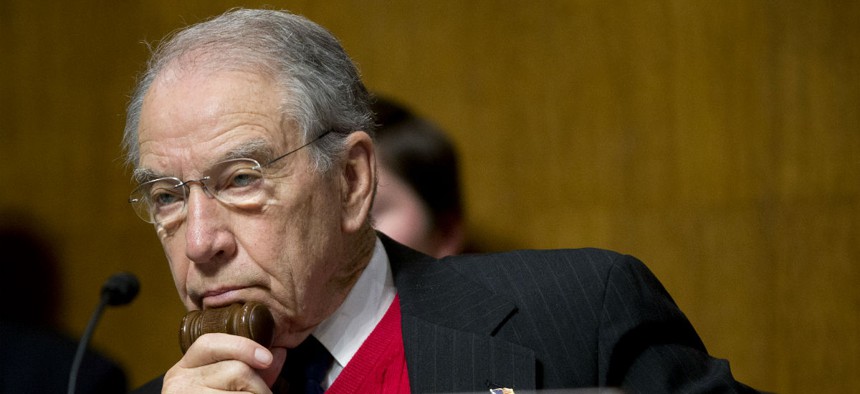
Report on the often opaque practice of administrative leave issued by Sen. Chuck Grassley, R-Iowa, has been more than a year in the making. Pablo Martinez Monsivais/AP
Agencies Spent $80M in 2014 Forcing Employees Not to Work
Lawmaker vows to reform administrative leave by forcing agencies to suspend or fire more workers.
A sample of 18 federal agencies spent more than $80 million last year for some employees to not work for at least one month, according to a new report, and one lawmaker has vowed to finally reform the process legislatively.
Sen. Chuck Grassley, R-Iowa, released a report more than one year in the making to expose the often opaque practice of administrative leave. Agencies frequently use the practice, in which employees are paid their normal salaries while prohibited from working, while investigating workers for misconduct. Administrative leave is not defined in federal statute, which Grassley lamented leaves agencies with great flexibility in how they use it. The practice, he said, is “ripe for abuse.”
Grassley -- who has spent more than a decade crusading against such abuses -- sent letters to agencies across government asking for details on their use of mandatory paid time off after a 2014 Government Accountability Office report estimated the government spent $3.1 billion on the practice. The $80 million figure did not include responses from two large departments -- Defense, which declined to report its figures, and State, which did not track them.
The agencies that did respond to Grassley’s request typically did not explain in detail why they used administrative leave, though they often cited “misconduct.” The Interior Department, meanwhile, placed teachers on administrative leave during the school year while paying them prorated salaries when they were not working as educators.
Most agencies did place caps on how long administrative leave could continue for an employee. The Housing and Urban Development Department -- which refers to the practice as “excused absence” -- spent the most on administrative leave lasting more than one month on a per employee basis, averaging about $50,000 for each use. The Homeland Security Department and the Social Security Administration spent more than $1 million in 2014 alone on employees who were on administrative leave for at least one year. DHS reported six employees who were paid to not work due to misconduct for more than two years at the time of its response to Grassley, but did not explain why the leave lasted so long.
Grassley said in the report the explanations for year-plus uses of mandatory paid leave were “so broad and vague,” it was impossible to determine their appropriateness.
“We found that agencies appear to be using administrative leave as a way to place employees in a catch-all limbo status rather than address personnel problems expeditiously,” the report's authors on the Senate Judiciary Committee wrote.
The departments of Justice and Interior had caps on administrative leave of 10 and 45 days, respectively, but could extend those maximums with permission from within the agencies.
The Office of Personnel Management put out guidance earlier this year to clarify when agencies should use administrative leave, noting most extensive or indefinite uses were not appropriate. The primary function of administrative leave, OPM said, was to allow for activities directly related to the agency mission, or other undertakings such as the Employee Assistance Program, blood donation and agency-approved volunteering. The guidance allows for mandatory paid leave for workers involved in misconduct only when they pose a threat to themselves, others or federal property.
OPM encouraged alternative actions whenever possible, such as leave without pay, indefinite suspensions or firing the employee without notice if there is “reasonable cause to believe the employee has committed a crime” for which he or she could go to prison. Grassley said such actions would benefit both taxpayers and the employees, who have no appeal rights to the Merit Systems Protection Board while on administrative leave.
“Taking an adverse action in those serious cases where employees pose an immediate threat would lower costs and trigger due process rights for the employees,” the committee staff wrote, “rather than keeping the taxpayers on the hook and the employee in limbo for, in some cases, years.”
Grassley said agencies sometimes used administrative leave to avoid uncomfortable or unjustifiable personnel action. Forced paid leave is one means by which agencies can retaliate against whistleblowers, the senator said. He added that oversight bodies, employees, taxpayers and agencies themselves would be better served by a “unified framework” that more clearly spelled out the rules of administrative leave.
“That framework should provide consistent guidance on administrative leave and appropriate checks on its use, as well as benchmarks and reporting requirements that allow for a clear understanding of its cost and practical application across the federal government,” the senator and his staffers wrote in the report.
Specifically, Grassley said he is working with the Senate Homeland Security and Governmental Affairs Committee -- which has oversight of federal leave policy -- to draft legislation that: defines administrative leave in statue, incentivizes ulterior punishments for malfeasant employees such as reassignments or indefinite suspensions, limits the length of time an employee can be forced to not work with pay, requires oversight of whether an employee actually poses a threat in the workplace, enables employees to appeal the use of the practice and provides better tracking and recording.
Grassley’s report follows his findings on abuses of administrative leave at DHS and the Veterans Affairs Department. Last month, an Environmental Protection Agency inspector general report found employees engaging in sex with minors and drug use were placed on administrative leave for extended periods of time.







